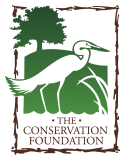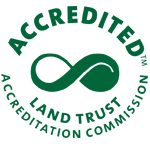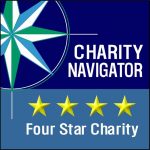Our very own President/CEO Brook McDonald was recently featured in a Q & A-style article in West Suburban Living Magazine! Many thanks to Chuck Cozette and our friends at West Suburban Living for putting our fearless leader into this well-deserved spotlight.
Q&A With Brook McDonald
The longtime CEO of The Conservation Foundation has helped preserve 36,000 acres of open lands
From catching frogs and crawdads in the creek near his Ohio boyhood home, to college classes in ecology and environmental education, to early jobs with the Wheaton Park District and the DuPage Forest Preserve, Brook McDonald was cultivating a passion for the outdoors — a passion that would ultimately prepare him to serve as a key point person in helping preserve 36,000 acres of open lands in the western suburbs. In the process, as CEO of The Conservation Foundation for the past 30 years, McDonald has grown the once tiny organization into “a force to be reckoned with” in the field of conservation and environmental preservation. While the immediate benefits of the expanded open spaces have been significant, the positive legacy will be even greater for generations of area residents to come.
What were your interests as a kid? Any especially noteworthy experiences or early mentors that had a significant influence on you, especially as it relates to your career?
BM: I grew up in the Columbus, Ohio area. As a kid, I played all kinds of sports and spent a LOT of time outside running around the neighborhood with friends and hanging out in a nearby woods, fishing in the creek, and trying to catch frogs and crawdads. I believe that’s where I learned to love the outdoors. I was also fortunate to have a high school teacher and coach who saw my passion for nature and conservation and helped guide me in the right direction. I think kids need free time to play outside, especially in a natural setting. Research shows that’s very important to their mental, social and physical growth.
You attended Otterbein College for undergrad and then Ohio State University for grad school. What did you study and did you have any specific career goals in mind during those years?
BM: My undergraduate degree at Otterbein (Westerville, Ohio) was in Life Sciences with a focus on ecology and geology. I wanted to be a wildlife biologist or forest ranger. As I spent more time with groups outside leading tours and educational activities as an intern, I realized that environmental education was really the thing for me. So I went to THE Ohio State University for grad school and received a Master’s in Natural Resources Management with a focus on environmental education.
What were your jobs prior to The Conservation Foundation and what were the key things you learned and carried forward from those experiences that informed your later work at the Foundation?
BM: While in graduate school, I worked part-time for the Ohio Department of Natural Resources as a stream biologist/educator and for the Metro Parks (like a forest preserve district) as a naturalist and ran a small nature center. I really learned a lot from those experiences and combined with what I was learning in school, it was an awesome combination. After grad school, I got my first full-time gig in 1987 working with the Wheaton Park District as its first naturalist and natural resources manager, working mostly in the Lincoln Marsh. What a great town and park district! From there, I worked for the DuPage Forest Preserve District from 1992-1996 as its director of public affairs. I learned a lot about the county, local politics and legislation, and that really prepared me for my work here at The Conservation Foundation. Working with the public is one of the best experiences I have had as you really get to meet all kinds of different people. I still enjoy that aspect of my job.
The Forest Foundation (the original name of The Conservation Foundation) was founded in 1972 by some early west suburban movers and shakers including Paul Butler, founder of Oak Brook, and Brooks McCormick, the CEO of the then family-owned International Harvester. But at the time you came on board in 1996, the organization was still very small. What attracted you to the job and what were the goals when you came on board?
BM: I was fortunate to know Brooks McCormick a little and was a volunteer with The Conservation Foundation for many years before working here. So I knew the Foundation well, they knew me, and I was very impressed with the people involved — Jean Connell, Bob Schillerstrom, Doug Mains, Dorothy Dean, Steve Van Arsdell, Betty Bradshaw — lots of movers and shakers and I wanted to be part of an organization that wanted to get things done, not just sit around and talk. My charge when I was hired was to grow the organization and make sure we stayed true to our roots as a reasoned voice for local conservation and focused on our mission of preserving land and cleaning up our local rivers. The board challenged me to take the organization to a higher level and engage our communities, increase membership (we now have more than 6,000 members), and focus on measurable impact. Someone recently told me we have become a “force to be reckoned with,” and I’m very proud of that.
What were those early years like in trying to get key constituencies on board with the Foundation’s mission and what were some key early benchmark achievements that helped propel the Foundation’s growth and success?
BM: Back in the 90s environmental issues were just starting to track. I think the recognition and attention surrounding Earth Day’s 20th anniversary in 1990 really increased awareness in the suburbs, and we just tried to leverage that and crank it up. We had a very strong and well-respected board and we started hiring high quality, professional staff. That was key because we now had full-time professional staff working side-by- side with volunteers, and that really made a difference. I think when we successfully ran the DuPage Forest Preserve’s referendum campaign in 1997, that was a real turning point. After that, forest preserves in Kane and Will counties contacted us, then shortly thereafter we expanded our service territory beyond DuPage to Kane, Kendall and Will counties. That opened up a lot of doors. Then, we received a $1 million grant from the EPA to do stream restoration work on the DuPage River. I didn’t have a lot of traditional fundraising experience, so we focused on doing good conservation, and people and money found us. People and funders want to support work they think is impactful and lasting. So it’s interesting how one successful event led to many others, and it hasn’t stopped since.
Under your leadership, The Conservation Foundation has grown to more than 50 employees, now has a multi-million-dollar budget and has helped preserve more than 36,000 acres of land. How has that land been acquired?
BM: When I started in 1996, there were only three of us. I have always said bigger is not always better, but it’s true that you have to reach scale to really make an impact, so we have been very methodical on how we have grown over the past 30 years. We use all of the land preservation tools at our disposal — outright acquisitions, land donations, conservation easements, joint acquisitions, and buy-and-hold for local agencies, where we purchase the land, hold onto it until the agency can get a grant, then sell it to the agency, which uses the grant funds and saves taxpayer dollars. So we have to be creative and flexible to get the job done.
You mentioned running a successful referendum campaign for the DuPage Forest Preserve and a number of others since. Walk us through The Conservation Foundation’s role in the referenda process; how referenda funds are allocated; how it is determined what land to acquire; and who owns the land after it is acquired?
BM: We have run 16 successful conservation ballot measures for local forest preserve and park districts, and other open space agencies that have raised more than $1 billion. In these cases, the agencies themselves cannot advocate for a YES vote, but we can. So we educate and encourage voters to support conservation and local open space referenda. Then the agency gets the referendum funds (not us) and buys the open space for public enjoyment. We see this as a very important extension of our mission. In the cases where we purchase land ourselves with money we have raised privately, we either hold the land temporarily until a local conservation agency can buy it from us later, or in the case of our Dayton Bluffs Preserve near Ottawa, we keep it long term and manage it for public use. In most cases, we are partnering with a local public entity that has land conservation and public access as their main mission, such as forest preserve districts. Our 60-acre McDonald Farm in Naperville was donated to us in 1992 and we are holding onto it as it is now our headquarters. We also grow organically-certified veggies at the farm through our Green Earth Harvest program, the proceeds of which are donated to five area food pantries and provided to more than 700 families who purchase shares of the harvest.
With the anti-tax sentiment of recent years, why do you think the open lands related referenda have bucked that trend and passed the last 16 times?
BM: That’s the great thing about conservation — it’s not a partisan issue. It’s not political and one of the few issues that most of us can agree on. Most people see the value in having parks, forest preserves, clean water and air, and trails and other green spaces in communities that enhance our quality of life. People want to live and work in communities that have these amenities, and we realize they create healthy, vibrant communities. And since COVID, many people now realize how important being outside in nature is to our mental, physical and spiritual health. How can you put a price on that? And the referenda that have passed have been a nominal tax increase, so most people see it as a good value. We like to say that conservation and open space is one of the few issues that can bring us together. We like to focus on lands along rivers and streams that also protect watersheds. By that we mean when we preserve land along waterways, we are enhancing water quality, wildlife habitat, and stormwater management, and creating greenways for people to enjoy. It’s a win-win for everyone, so we and our local public agency partners are always working to enhance and extend those types of land purchases, and as a private, not-for-profit charitable organization, we continue to bring private resources to the table to help.
In addition to acquiring available lands to maintain open spaces, the Foundation is also a leader in ecological restoration efforts, especially with local rivers and watersheds. Tell us a little about those efforts, what is involved, what has been achieved and why it’s important?
BM: I mentioned earlier that almost everything we do is in collaboration with others. Our river and stream restoration and outreach work is conducted through coalitions with other not-for-profits and local units of government. We helped create several local watershed “work groups” that we staff with our professional employees, and they form their own local boards and focus on science-based and mostly locally funded restoration projects. We have found that removing dams, and restoring natural water flow and adjacent habitat is about the most important thing we can do to improve our water quality and restore the health of our rivers, along with managing stormwater runoff and chlorides. We have a long 20+-year partnership with DuPage County Stormwater Management and the DuPage River Salt Creek Workgroup that has yielded many positive improvements to our local waterways.
In recent years, The Conservation Foundation has become involved on a much more grassroots neighborhood level, helping homeowners, homeowner associations and municipal partners achieve their conservation goals — from providing rain barrels and composters to helping with earth-friendly landscaping and community gardens. Tell us why these smaller activities have been made more of a priority and how they fit into the Foundation’s overall mission?
BM: Community conservation is one of the Foundation’s primary mission priorities. We can preserve and restore all kinds of places, but if people don’t understand or care, I’m not sure these places are really “preserved in perpetuity.” We have to connect hearts and minds to these special places so people and communities become invested and will fight to protect them. So we have many educational and public engagement programs that inform and connect people to places, encourage them to seek outdoor experiences and even create their own mini “forest preserve” in their yards through our Conservation@Home program. This is one of our most popular programs as people love to learn how to make their yards more environmentally-friendly through native landscaping, rain barrels and other water conservation techniques, and reduced pesticide use, which lessens their environmental footprint. We also have many youth education programs where we partner with other local youth-serving organizations, and since COVID our Nature Rx initiative has really taken off.
What aspects of your job do you find the most challenging and what aspects bring the most joy and satisfaction?
BM: I guess what challenges me the most is learning to say NO. There is so much to do and everyone here wants our help, but we don’t always have the capacity to do everything, so that is frustrating. We have grown so much over the past 30 years and we are doing so much more these days on limited budgets, but there is always more to do. What I enjoy most are the people. From my employees to the board, volunteers and donors and our partners, we truly work in an area with quality people and a spirit of community. That is so powerful. Of course, I always get a jolt when we purchase some land and know it’ll be preserved forever. But in the end, we are doing that for both nature and people, so the people aspect of this business is so rewarding. I’ve met some truly amazing people and they have rubbed off on me, and hopefully made me a better person.
Is it fair to assume you are an outdoors-person yourself and, if so, what activities do you like to do most?
BM: You will find me in a kayak on a local river, usually the Fox River, whenever I have an opportunity. We live in unincorporated Kendall County near Plano. (having lived in Warrenville and Wheaton before that). It’s beautiful out here. We love the open spaces, rolling hills, farm fields and the Fox River. My wife and I hike almost every weekend and we are fortunate to have seven forest preserves or other natural area parks within a 15-minute drive of where we live. What’s really cool is that The Conservation Foundation helped preserve most of them, so when we hike it feels good to know we had a hand in preserving the land.
Reprinted with permission from West Suburban Living Magazine
Published July 23rd, 2025



